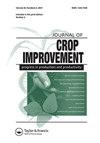氧化铁纳米颗粒对龙葵生理变化的体外评价
IF 1.5
Q3 AGRONOMY
引用次数: 1
摘要
摘要应用铁纳米粒子作为铁肥料可以成为治理农作物缺铁的一种有效策略。然而,铁的毒性不应被忽视,应确定其适当的浓度。在体外比较了铁纳米粒子和乙二胺四乙酸铁(FeEDTA)对绒毛茄铁积累、光合色素、可溶性碳水化合物和蛋白质、抗氧化酶活性和木质化的影响。培养基的制备方法有两种:1)以628 mg L−1 FeEDTA为对照,2)不同浓度的氧化铁纳米粒子(628和730 mg L−L,pH为5.2,628和830 mg L−i,pH为5.9)。与对照组相比,使用628 mg L−1纳米颗粒浓度生长的植物的叶和茎中的铁含量、叶绿素、可溶性碳水化合物和蛋白质的量有所下降,但在730 mg L−和830 mg L−的浓度下,相同的参数有所增加。铁纳米粒子降低了过氧化氢酶和抗坏血酸过氧化物酶的活性。愈创木酚过氧化物酶活性和类胡萝卜素含量在FeEDTA和纳米颗粒处理之间没有显著差异。叶和茎木质素水平与对照(FeEDTA)没有差异。在体外条件下,可以用最佳浓度的铁纳米粒子代替FeEDTA。需要进行体内实验,将这些结果推广到田间种植的植物中,因为铁纳米颗粒比铁螯合物有一些优势,而铁螯合物高度依赖于土壤条件。缩写:APX:抗坏血酸过氧化物酶;CAT:过氧化氢酶;FeEDTA:乙二胺四乙酸铁(II);GP:愈创木酚过氧化物酶;MS:Murashige和Skoog培养基本文章由计算机程序翻译,如有差异,请以英文原文为准。
In-vitro evaluation of physiological changes caused by iron oxide nanoparticles in Solanum villosum
ABSTRACT Application of iron nanoparticles as iron fertilizer can be a functional strategy to manage iron deficiency in agricultural crops. However, the toxicity of iron should not be ignored and its proper concentrations should be determined. The effect of iron nanoparticles and Fe (II) ethylenediaminetetraacetate (FeEDTA) on iron accumulation, photosynthetic pigments, soluble carbohydrate and protein, antioxidant enzymes activity, and lignification were compared in vitro in Solanum villosum. Culture media were prepared in two ways: 1) including 628 mg L−1 FeEDTA as control, and 2) different concentrations of iron oxide nanoparticles (628 and 730 mg L−1 in pH of 5.2, and 628 and 830 mg L−1 in pH of 5.9). Seeds were germinated on culture media and biochemical parameters were measured at the end of the fourth week. The iron content, amount of chlorophyll, soluble carbohydrate and protein in leaves and stems of the plants grown using the nanoparticle concentration of 628 mg L−1 decreased compared to the control, but the same parameters increased in concentrations of 730 and 830 mg L−1. Iron nanoparticles decreased catalase and ascorbate peroxidase activities. Guaiacol peroxidase activity and carotenoid content showed no significant difference between FeEDTA and nanoparticle treatments. Leaf and stem lignin levels did not differ from control (FeEDTA). FeEDTA can be replaced by optimum concentrations of iron nanoparticle under in vitro conditions. In vivo experiments are needed to generalize these results for field-grown plants, because iron nanoparticles have some advantage over iron chelate, which is highly dependent on soil conditions. Abbreviations: APX: ascorbate peroxidase; CAT: catalase; FeEDTA: Fe (II) ethylenediaminetetraacetate; GP: guaiacol peroxidase; MS: Murashige and Skoog medium
求助全文
通过发布文献求助,成功后即可免费获取论文全文。
去求助
来源期刊

Journal of Crop Improvement
Multiple-
CiteScore
3.30
自引率
7.70%
发文量
42
期刊介绍:
Journal of Crop Science and Biotechnology (JCSB) is a peer-reviewed international journal published four times a year. JCSB publishes novel and advanced original research articles on topics related to the production science of field crops and resource plants, including cropping systems, sustainable agriculture, environmental change, post-harvest management, biodiversity, crop improvement, and recent advances in physiology and molecular biology. Also covered are related subjects in a wide range of sciences such as the ecological and physiological aspects of crop production and genetic, breeding, and biotechnological approaches for crop improvement.
 求助内容:
求助内容: 应助结果提醒方式:
应助结果提醒方式:


